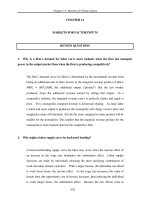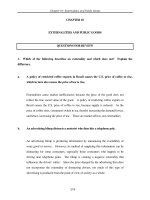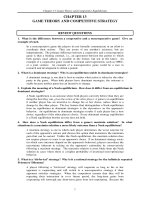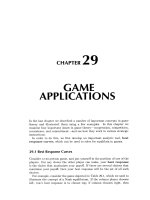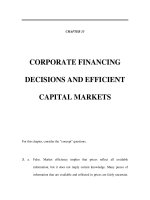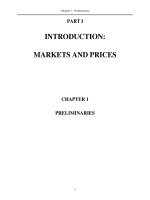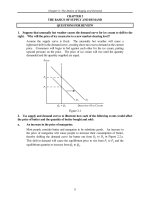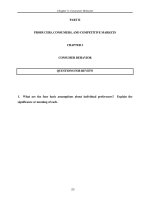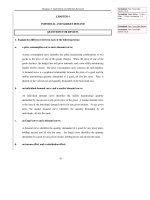Câu hỏi đánh giá môn Kinh tế vĩ mô bằng tiếng Anh- Chương 13
Bạn đang xem bản rút gọn của tài liệu. Xem và tải ngay bản đầy đủ của tài liệu tại đây (67.63 KB, 14 trang )
Chapter 13: Game Theory and Competitive Equilibrium
1
CHAPTER 13
GAME THEORY AND COMPETITIVE STRATEGY
REVIEW QUESTIONS
1. What is the difference between a cooperative and a noncooperative game? Give an
example of each.
In a noncooperative game the players do not formally communicate in an effort to
coordinate their actions. They are aware of one another’s existence, but act
independently. The primary difference between a cooperative and a noncooperative
game is that a binding contract, i.e., an agreement between the parties to which
both parties must adhere, is possible in the former, but not in the latter. An
example of a cooperative game would be a formal cartel agreement, such as OPEC,
or a joint venture. An example of a noncooperative game would be a race in
research and development to obtain a patent.
2. What is a dominant strategy? Why is an equilibrium stable in dominant strategies?
A dominant strategy is one that is best no matter what action is taken by the other
party to the game. When both players have dominant strategies, the outcome is
stable because neither party has an incentive to change.
3. Explain the meaning of a Nash equilibrium. How does it differ from an equilibrium in
dominant strategies?
A Nash equilibrium is an outcome where both players correctly believe that they are
doing the best they can, given the action of the other player. A game is in equilibrium
if neither player has an incentive to change his or her choice, unless there is a
change by the other player. The key feature that distinguishes a Nash equilibrium
from an equilibrium in dominant strategies is the dependence on the opponent’s
behavior. An equilibrium in dominant strategies results if each player has a best
choice, regardless of the other player’s choice. Every dominant strategy equilibrium
is a Nash equilibrium but the reverse does not hold.
4. How does a Nash equilibrium differ from a game’s maximin solution? In what
situations is a maximin solution a more likely outcome than a Nash equilibrium?
A maximin strategy is one in which each player determines the worst outcome for
each of the opponent’s actions and chooses the option that maximizes the minimum
gain that can be earned. Unlike the Nash equilibrium, the maximin solution does
not require players to react to an opponent’s choice. If no dominant strategy exists
(in which case outcomes depend on the opponent’s behavior), players can reduce the
uncertainty inherent in relying on the opponent’s rationality by conservatively
following a maximin strategy. The maximin solution is more likely than the Nash
solution in cases where there is a higher probability of irrational (non-optimizing)
behavior.
5. What is a “tit-for-tat” strategy? Why is it a rational strategy for the infinitely repeated
Prisoners’ Dilemma?
A player following a “tit-for-tat” strategy will cooperate as long as his or her
opponent is cooperating and will switch to a noncooperative strategy if their
opponent switches strategies. When the competitors assume that they will be
repeating their interaction in every future period, the long-term gains from
cooperating will outweigh any short-term gains from not cooperating. Because the
Chapter 13: Game Theory and Competitive Equilibrium
2
“tit-for-tat” strategy encourages cooperation in infinitely repeated games, it is
rational.
6. Consider a game in which the Prisoners’ Dilemma is repeated 10 times, and both
players are rational and fully informed. Is a tit-for-tat strategy optimal in this case?
Under what conditions would such a strategy be optimal?
Since cooperation will unravel from the last period back to the first period, the “tit-
for-tat” strategy is not optimal when there is a finite number of periods and both
players anticipate the competitor’s response in every period. Given that there is no
response possible in the eleventh period for action in the tenth (and last) period,
cooperation breaks down in the last period. Then, knowing that there is no
cooperation in the last period, players should maximize their self-interest by not
cooperating in the second-to-last period. This unraveling occurs because both
players assume that the other player has considered all consequences in all periods.
However, if there is some doubt about whether the opponent has fully anticipated
the consequences of the “tit-for-tat” strategy in the final period, the game will not
unravel and the “tit-for-tat” strategy can be optimal.
7. Suppose you and your competitor are playing the pricing game shown in Table 13.8.
Both of you must announce your prices at the same time. Might you improve your
outcome by promising your competitor that you will announce a high price?
If the game is to be played only a few times, there is little to gain. If you are Firm 1
and promise to announce a high price, Firm 2 will undercut you and you will end up
with a payoff of -50. However, next period you will undercut too, and both firms will
earn 10. If the game is played many times, there is a better chance that Firm 2 will
realize that if it matches your high price, the long-term payoff of 50 each period is
better than 100 at first and 10 thereafter.
8. What is meant by “first-mover advantage”? Give an example of a gaming situation
with a first-mover advantage.
A “first-mover” advantage can occur in a game where the first player to act receives
the highest payoff. The first-mover signals his or her choice to the opponent, and
the opponent must choose a response, given this signal. The first-mover goes on the
offensive and the second-mover responds defensively. In many recreational games,
from chess to football, the first-mover has an advantage. In many markets, the first
firm to introduce a product can set the standard for competitors to follow. In some
cases, the standard-setting power of the first mover becomes so pervasive in the
market that the brand name of the product becomes synonymous with the product,
e.g., “Kleenex,” the name of Kleenex-brand facial tissue, is used by many consumers
to refer to facial tissue of any brand.
9. What is a “strategic move”? How can the development of a certain kind of reputation
be a strategic move?
A strategic move involves a commitment to reduce one’s options. The strategic move
might not seem rational outside the context of the game in which it is played, but it
is rational given the anticipated response of the other player. Random responses to
an opponent’s action may not appear to be rational, but developing a reputation of
being unpredictable could lead to higher payoffs in the long run. Another example
would be making a promise to give a discount to all previous consumers if you give a
discount to one. Such a move makes the firm vulnerable, but the goal of such a
strategic move is to signal to rivals that you won’t be discounting price and hope
that your rivals follow suit.
Chapter 13: Game Theory and Competitive Equilibrium
3
10. Can the threat of a price war deter entry by potential competitors? What actions
might a firm take to make this threat credible?
Both the incumbent and the potential entrant know that a price war will leave their
firms worse off. Normally, such a threat is not credible. Thus, the incumbent must
make his or her threat of a price war believable by signaling to the potential entrant
that a price war will result if entry occurs. One strategic move is to increase
capacity, signaling a lower future price, and another is to engage in apparently
irrational behavior. Both types of strategic behavior might deter entry, but for
different reasons. While an increase in capacity reduces expected profits by
reducing prices, irrational behavior reduces expected profits by increasing
uncertainty, hence increasing the rate at which future profits must be discounted
into the present.
11. A strategic move limits one’s flexibility and yet gives one an advantage. Why? How
might a strategic move give one an advantage in bargaining?
A strategic move influences conditional behavior by the opponent. If the game is
well understood and the opponent’s reaction can be predicted, a strategic move
leaves the player better off. Economic transactions involve a bargain, whether
implicit or explicit. In every bargain, we assume that both parties attempt to
maximize their self-interest. Strategic moves by one player provide signals to which
another player reacts. If a bargaining game is played only once (so no reputations
are involved), the players might act strategically to maximize their payoffs. If
bargaining is repeated, players might act strategically to establish reputations for
expected negotiations.
Chapter 13: Game Theory and Competitive Equilibrium
4
EXERCISES
1. In many oligopolistic industries, the same firms compete over a long period of time,
setting prices and observing each other’s behavior repeatedly. Given that the number of
repetitions is large, why don’t collusive outcomes typically result?
If games are repeated indefinitely and all players know all payoffs, rational behavior
will lead to apparently collusive outcomes, i.e., the same outcomes that would result
if firms were actively colluding. All payoffs, however, might not be known by all
players. Sometimes the payoffs of other firms can only be known by engaging in
extensive (and costly) information exchanges or by making a move and observing
rivals’ responses. Also, successful collusion encourages entry. Perhaps the greatest
problem in maintaining a collusive outcome is that changes in market conditions
change the collusive price and quantity. The firms then have to repeatedly change
their agreement on price and quantity, which is costly, and this increases the ability
of one firm to cheat without being discovered.
2. Many industries are often plagued by overcapacity--firms simultaneously make major
investments in capacity expansion, so total capacity far exceeds demand. This happens
in industries in which demand is highly volatile and unpredictable, but also in
industries in which demand is fairly stable. What factors lead to overcapacity? Explain
each briefly.
In Chapter 12, we found that excess capacity may arise in industries with easy entry
and differentiated products. In the monopolistic competition model, downward-
sloping demand curves for each firm lead to output with average cost above
minimum average cost. The difference between the resulting output and the output
at minimum long-run average cost is defined as excess capacity. In this chapter, we
saw that overcapacity could be used to deter new entry; that is, investments in
capacity expansion could convince potential competitors that entry would be
unprofitable. (Note that although threats of capacity expansion may deter entry,
these threats must be credible.)
3. Two computer firms, A and B, are planning to market network systems for office
information management. Each firm can develop either a fast, high-quality system (H),
or a slower, low-quality system (L). Market research indicates that the resulting profits
to each firm for the alternative strategies are given by the following payoff matrix:
Firm B
H L
H 30, 30 50, 35
Firm A
L 40, 60 20, 20
a. If both firms make their decisions at the same time and follow maximin (low-risk)
strategies, what will the outcome be?
With a maximin strategy, a firm determines the worst outcome for each option, then
chooses the option that maximizes the payoff among the worst outcomes. If Firm A
chooses H, the worst payoff would occur if Firm B chooses H: A’s payoff would be 30.
If Firm A chooses L, the worst payoff would occur if Firm B chooses L: A’s payoff
would be 20. With a maximin strategy, A therefore chooses H. If Firm B chooses L,
the worst payoff would occur if Firm A chooses L: the payoff would be 20. If Firm B
chooses H, the worst payoff, 30, would occur if Firm A chooses L. With a maximin
Chapter 13: Game Theory and Competitive Equilibrium
5
strategy, B therefore chooses H. So under maximin, both A and B produce a high-
quality system.
b. Suppose both firms try to maximize profits, but Firm A has a head start in
planning, and can commit first. Now what will the outcome be? What will the
outcome be if Firm B has a head start in planning and can commit first?
If Firm A can commit first, it will choose H, because it knows that Firm B will
rationally choose L, since L gives a higher payoff to B (35 vs. 30). This gives Firm A
a payoff of 50. If Firm B can commit first, it will choose H, because it knows that
Firm A will rationally choose L, since L gives a higher payoff to A (40 vs. 30). This
gives Firm B a payoff of 60.
c. Getting a head start costs money (you have to gear up a large engineering team).
Now consider the two-stage game in which first, each firm decides how much
money to spend to speed up its planning, and second, it announces which product
(H or L) it will produce. Which firm will spend more to speed up its planning?
How much will it spend? Should the other firm spend anything to speed up its
planning? Explain.
In this game, there is an advantage to being the first mover. If A moves first, its
profit is 50. If it moves second, its profit is 40, a difference of 10. Thus, it would be
willing to spend up to 10 for the option of announcing first. On the other hand, if B
moves first, its profit is 60. If it moves second, its profit is 35, a difference of 25, and
thus would be willing to spend up to 25 for the option of announcing first. Once
Firm A realizes that Firm B is willing to spend more on the option of announcing
first, then the value of the option decreases for Firm A, because if both firms were to
invest both firms would choose to produce the high-quality system. Therefore, Firm
A should not spend money to speed up the introduction of its product if it believes
that Firm B is spending the money. However, if Firm B realizes that Firm A will
wait, Firm B should only spend enough money to discourage Firm A from engaging
in research and development, which would be an amount slightly more than 10 (the
maximum amount A is willing to spend).
4. Two firms are in the chocolate market. Each can choose to go for the high end of the
market (high quality) or the low end (low quality). Resulting profits are given by the
following payoff matrix:
Firm 2
Low High
Low -20, -30 900, 600
Firm 1
High 100, 800 50, 50
a. What outcomes, if any, are Nash equilibria?
If Firm 2 chooses Low and Firm 1 chooses High, neither will have an incentive to
change (100 > -20 for Firm 1 and 800 > 50 for Firm 2). If Firm 2 chooses High and
Firm 1 chooses Low, neither will have an incentive to change (900 > 50 for Firm 1
and
600 > -30 for Firm 2). Both outcomes are Nash equilibria.
